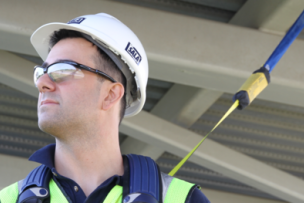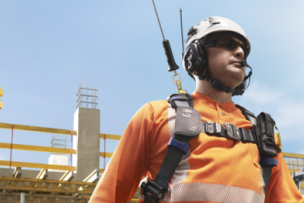Consider, for example, a worker who is trying to communicate with others on a noisy factory floor. Instead of having to shout to be heard, or even having to meet face to face to exchange vital information, workers could use technology such as amplifying headphones or communication headsets to communicate at a safe distance, while also protecting their hearing.
Here are examples of wearable safety technologies that can make workers safer while also creating more efficiencies for your company.
Read more: Shift Work and Health: Why You Need a Strategy to Keep Your Workers Safe
Connecting the Workplace With IoT
Manufacturing settings are dynamic and constantly changing. For example, a warehouse floor will constantly receive new raw materials for use in manufacturing processes, while various workers are busy with their individual projects or intermittently using machinery and other hardware.
In this scenario, with constant change happening and equipment continually on the move in the workspace, it can be challenging to remain aware of potential dangers in your surroundings.
Using the power of the Internet of Things (IoT), networked sensors and body-worn devices, manufacturers can now blend the physical and digital realms, allowing companies to manage their physical assets and improve safety and situational awareness.
For example, suppose that a worker is walking through a noisy workspace and cannot see that she will turn a corner and cross paths with a forklift that’s on the move. If both the workers and the heavy machinery in the workplace are connected to a smart network, it can determine their exact location, monitor movements and notify employees when a potentially dangerous collision may happen, or something within a plant has changed (a dangerous chemical spill or gas emission).
When using IoT and connected sensors, safety managers can see an overview of safety in a manufacturing facility at a glance—and remotely. All the data are relayed back to a central hub that allows administrators to review information about individual employees or crunch data to improve safety. A safety manager can be located off-site, yet still monitor and communicate with workers.
Take, for example, a wearable gas detection device such as MSA Safety’s ALTAIR io 4 Gas Detection Wearable, which transmits real-time data, such as critical gas detection readings and location information, to a new cloud-based software platform. This allows safety managers to guide workers away from dangerous locations using real-time remote monitoring connected to global cellular connectivity and GPS location technology.
Improved safety can help improve business efficiency, too, as it helps mitigate the cost of workers’ compensation.
Read more: Machine Safety: Here’s Why You Should Be Taking It Seriously
Biomarker Monitoring
The wearable devices attached to employees send out data that can be crunched and the results used to give safety professionals “a set of watchful eyes to help ensure the health and well-being of the workforce, particularly lone workers,” notes a recent article on the topic by Safety+Health, a publication of the National Safety Council.
According to the report, recent safety initiatives taken from data analysis include:
- Using electroencephalogram devices to monitor workers’ stress levels at construction sites. Feeding data from EEG devices through deep learning neural networks (a set of algorithms designed to mimic human thought), allowed researchers to “discern which workers were stressed with an 86.6 percent accuracy, or ‘at least 6 percent’ better than other stress recognition methods.”
- Using wristband-type biosensors to measure stress, physical demands and risk perception among construction workers. The devices measure fatigue by focusing on aspects “such as how often workers’ heads move up and down or their eyes close, and for how long, and even how straight they walk.”
- Using wearable technologies and electronic smart devices to improve biomechanical risk assessments for musculoskeletal disorders, which are associated with manual work. Current risk assessment tools include ergonomic checklists and video or photo risk analyses.
Researchers are even going so far as to use the conductive features of human body tissues for data transmission between wearable, implanted and ingested medical devices, according to a report in IEEE Internet of Things Journal.
The researchers say the interconnection of wireless devices may be the foundation for something called “the Internet of Bodies (IoB)” in which smart devices and implants could be interconnected to monitor biomarkers in humans.
Read more: Get a Grip on Winter Weather Injuries with SureWerx Ice and Snow Traction Aids
Improving Communications
With the rise of COVID-19, wearable devices have developed to meet new safety needs, such as ensuring social distancing in workspaces—vital for keeping essential employees working and operations running.
They are also important for maintaining good communications between socially distanced workers.
Clear communication is essential to maintain a safe and productive workplace. Work in the manufacturing sector is frequently noisy and dangerous, and workers must be heard over industrial machinery and over significant distances.
For years workers had to make do with hearing protection in the form of “in-ear” protection—typically a small piece of foam that is compressed and inserted into the ear—or earmuff-style “over-ear” protection that covers the entire ear to shield it. What workers use depends on the decibel level of the noise environment.
Now, electronic communications technology such as amplifying headphones, communication headsets and two-way radios can aid communication from a safe distance, while some devices also offer ear protection.
How are you incorporating technology into your safety programs? What benefits have you seen? Share your thoughts and insights in the comments below.





Talk to Us!
Leave a reply
Your email address will not be published. Required fields are marked *